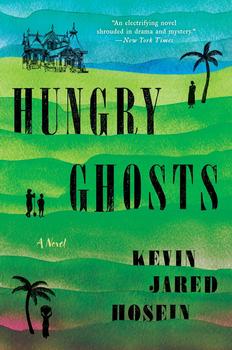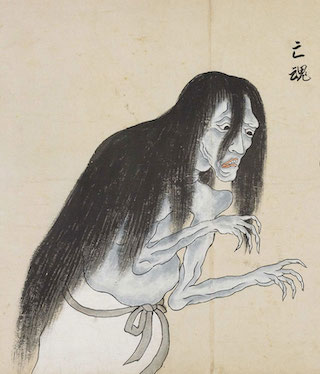Summary | Excerpt | Reviews | Beyond the Book | Read-Alikes | Genres & Themes | Author Bio

A Novel
by Kevin Jared HoseinThis article relates to Hungry Ghosts
Kevin Jared Hosein's title Hungry Ghosts has its origin in Taoism, Hinduism and Buddhism. According to the Concise Encyclopedia of Hinduism, hungry ghost, or preta "literally means 'one who has gone away from here' and is used to indicate the disembodied spirit of a dead person, especially during the first ten days after death." The word is also used to refer to a ghost, generally the spirit of a great sinner, whose unfulfilled desire or hunger compels it to wander in search of satiety, straddling the worlds of the living and the dead.
 Hungry ghosts have been portrayed in various artworks, often depicted with tiny mouths and throats and the swollen bellies of the starving, meaning they can never consume enough to ease the suffering of their hungers. Some of the images of hungry ghosts are believed to date back as far as the eighth century CE, such as the allegorical Gaki Sochi scrolls housed in Japan's Kyoto National Museum.
Hungry ghosts have been portrayed in various artworks, often depicted with tiny mouths and throats and the swollen bellies of the starving, meaning they can never consume enough to ease the suffering of their hungers. Some of the images of hungry ghosts are believed to date back as far as the eighth century CE, such as the allegorical Gaki Sochi scrolls housed in Japan's Kyoto National Museum.
Hungry ghosts also appear in pop culture. Late chef Anthony Bourdain collaborated with novelist Joel Rose to create a four-part comic book series titled Hungry Ghosts. Bourdain and Rose play on the ideas of hunger and greed throughout the collection. For example, "The Starving Skeleton" is a story about a ramen chef who, after refusing to give a beggar a free meal, gets eaten, piece by piece, by the same man he turned away. The beggar turns out to be a gashadokuro, or a "hungry skeleton."
Hosein's novel's first reference to a hungry ghost is in connection with a premature death. Fearing that the deceased's spirit, now a hungry ghost, may bring other ghosts to the barracks, characters attempt to appease the hungry ghost by feeding it rice balls. This tradition of feeding hungry ghosts is still practiced at Hungry Ghost Festivals around the world, with large-scale events occurring in China, Malaysia, Taiwan and Singapore, among other countries. The Hungry Ghost Festival, or Yu Lan, is a Taoist and Buddhist tradition celebrated on the 14th or 15th of the seventh month of the Chinese calendar. Participants prepare foods for both the dead and the living. Some festival goers believe it is best to make dishes in sets of threes in order to "symbolize the realms of heaven, earth, and the underworld." Despite its ominous name, the festival is meant to bring family together to celebrate both the living and the dead.
2023's celebration date falls on Wednesday, August 30th. If you plan on honoring the Hungry Ghost Festival, there are things you should know about the spirit world. Do not leave your clothes out to dry overnight, leave your slippers facing the bed, or whistle late at night unless you want visitors. If you do, you had better have some food available for your otherworldly guests — they are ravenous.
Illustration from the Bakemono zukushi scroll, 18th or 19th century Japan, artist unknown, courtesy of The Public Domain Review
Filed under Cultural Curiosities
![]() This "beyond the book article" relates to Hungry Ghosts. It originally ran in March 2023 and has been updated for the
February 2024 paperback edition.
Go to magazine.
This "beyond the book article" relates to Hungry Ghosts. It originally ran in March 2023 and has been updated for the
February 2024 paperback edition.
Go to magazine.
I always find it more difficult to say the things I mean than the things I don't.
Click Here to find out who said this, as well as discovering other famous literary quotes!
Your guide toexceptional books
BookBrowse seeks out and recommends the best in contemporary fiction and nonfiction—books that not only engage and entertain but also deepen our understanding of ourselves and the world around us.